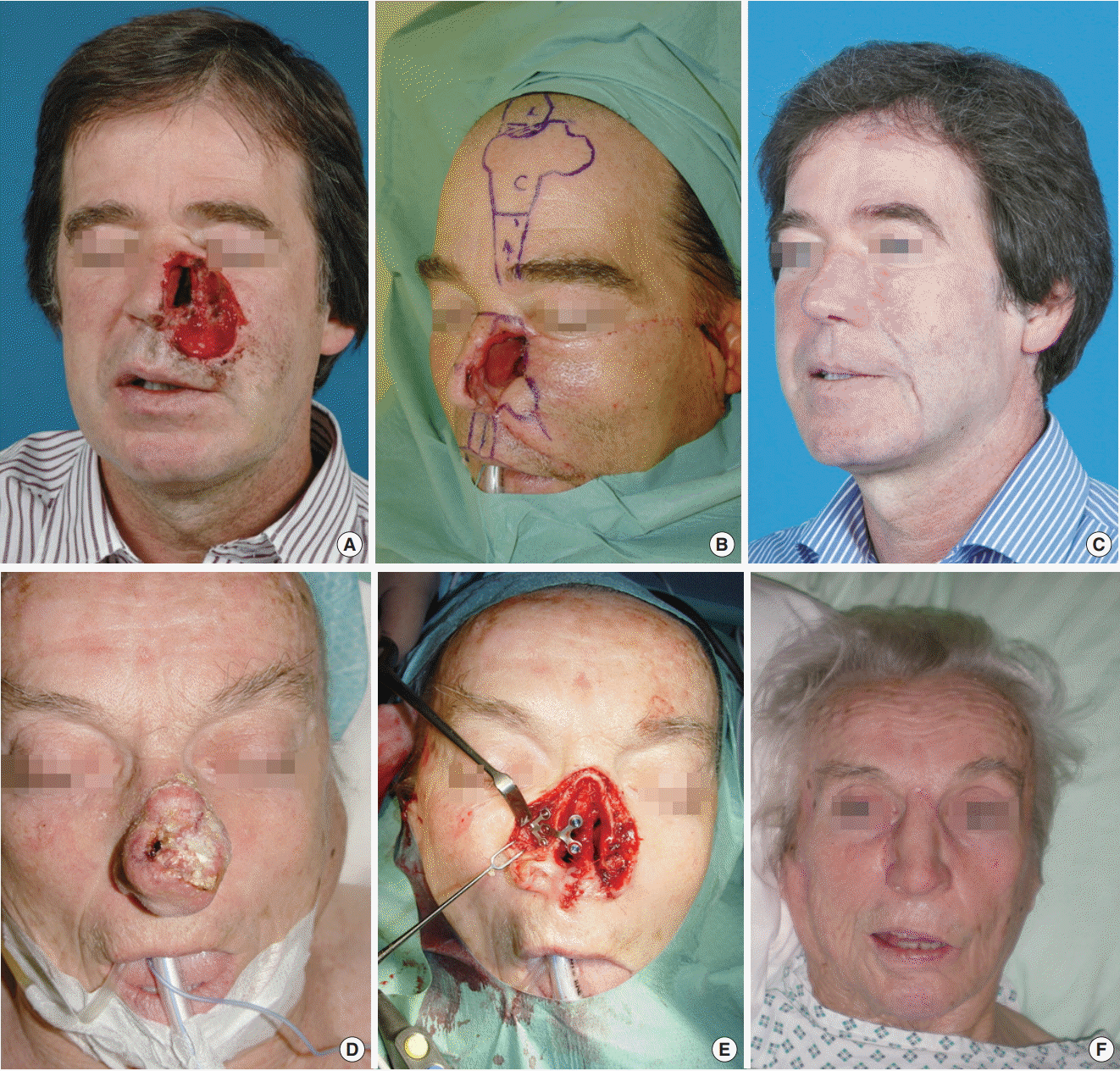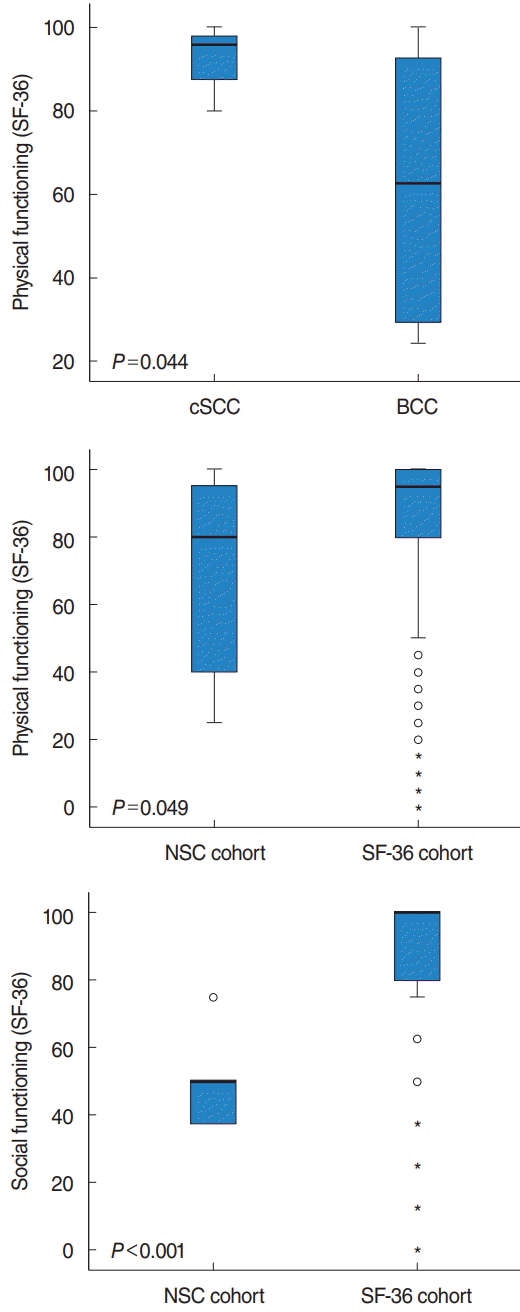1. Brana I, Siu LL. Locally advanced head and neck squamous cell cancer: treatment choice based on risk factors and optimizing drug prescription. Ann Oncol. 2012; Sep. 23 Suppl 10:x178–85.

2. Lee K, McKean ME, McGregor IA. Metastatic patterns of squamous carcinoma in the parotid lymph nodes. Br J Plast Surg. 1985; Jan. 38(1):6–10.

3. Wu S, Han J, Li WQ, Li T, Qureshi AA. Basal-cell carcinoma incidence and associated risk factors in U.S. women and men. Am J Epidemiol. 2013; Sep. 178(6):890–7.

4. Muzic JG, Schmitt AR, Wright AC, Alniemi DT, Zubair AS, Olazagasti Lourido JM, et al. Incidence and trends of basal cell carcinoma and cutaneous squamous cell carcinoma: a population-based study in Olmsted County, Minnesota, 2000 to 2010. Mayo Clin Proc. 2017; Jun. 92:890–8.
5. Bath-Hextall F, Leonardi-Bee J, Smith C, Meal A, Hubbard R. Trends in incidence of skin basal cell carcinoma: additional evidence from a UK primary care database study. Int J Cancer. 2007; Nov. 121(9):2105–8.

6. Preston DS, Stern RS. Nonmelanoma cancers of the skin. N Engl J Med. 1992; Dec. 327(23):1649–62.

7. Telfer NR, Colver GB, Morton CA; British Association of Dermatologists. Guidelines for the management of basal cell carcinoma. Br J Dermatol. 2008; Jul. 159(1):35–48.

8. Bussu F, Tagliaferri L, Mattiucci G, Parrilla C, Dinapoli N, Micciche F, et al. Comparison of interstitial brachytherapy and surgery as primary treatments for nasal vestibule carcinomas. Laryngoscope. 2016; Feb. 126(2):367–71.

9. Federspil PA. Ear epistheses as an alternative to autogenous reconstruction. Facial Plast Surg. 2009; Aug. 25(3):190–203.

10. Wray J, Morris CG, Kirwan JM, Amdur RJ, Werning JW, Dziegielewski PT, et al. Radiation therapy for nasal vestibule squamous cell carcinoma: a 40-year experience. Eur Arch Otorhinolaryngol. 2016; Mar. 273(3):661–9.

11. Veness MJ, Chong L, Tiver K, Gebski V. Basal cell carcinoma of the nose: an Australian and New Zealand radiation oncology patterns-of-practice study. J Med Imaging Radiat Oncol. 2008; Aug. 52(4):382–93.

12. Sedda AF, Rossi G, Cipriani C, Carrozzo AM, Donati P. Dermatological high-dose-rate brachytherapy for the treatment of basal and squamous cell carcinoma. Clin Exp Dermatol. 2008; Nov. 33(6):745–9.

13. Henry EL, Hart RD, Mark Taylor S, Trites JR, Harris J, O’Connell DA, et al. Total nasal reconstruction: use of a radial forearm free flap, titanium mesh, and a paramedian forehead flap. J Otolaryngol Head Neck Surg. 2010; Dec. 39(6):697–702.
14. Jeremic G, Brandt MG, Jordan K, Doyle PC, Yu E, Moore CC. Using photodynamic therapy as a neoadjuvant treatment in the surgical excision of nonmelanotic skin cancers: prospective study. J Otolaryngol Head Neck Surg. 2011; Feb. 40 Suppl 1:S82–9.
15. Kim HJ, Lee KH, Park SY, Kim HK. One-stage reconstruction for midfacial defect after radical tumor resection. Clin Exp Otorhinolaryngol. 2012; Mar. 5(1):53–6.

16. Park SS. Nasal reconstruction in the 21st century: a contemporary review. Clin Exp Otorhinolaryngol. 2008; Mar. 1(1):1–9.

17. van der Eerden PA, Prins ME, Lohuis PJ, Balm FA, Vuyk HD. Eighteen years of experience in Mohs micrographic surgery and conventional excision for nonmelanoma skin cancer treated by a single facial plastic surgeon and pathologist. Laryngoscope. 2010; Dec. 120(12):2378–84.

18. Wollina U, Bennewitz A, Langner D. Basal cell carcinoma of the outer nose: overview on surgical techniques and analysis of 312 patients. J Cutan Aesthet Surg. 2014; Jul. 7(3):143–50.

19. Zaoui K, Thielen HM, Plath M, Baumann I, Plinkert PK, Federspil PA. Quality of life after nasal cancer resection: surgical versus prosthetic rehabilitation. Rhinology. 2018; Dec. 56(4):400–6.
20. Zaoui K, Plinkert PK, Federspil PA. Primary surgical treatment of nasal vestibule cancer: therapeutic outcome and reconstructive strategies. Rhinology. 2018; Dec. 56(4):393–9.
21. Bulut OC, Plinkert PK, Wallner F, Baumann I. Quality of life in functional rhinoplasty: rhinoplasty outcomes evaluation German version (ROE-D). Eur Arch Otorhinolaryngol. 2016; Sep. 273(9):2569–73.

22. Bulut OC, Wallner F, Plinkert PK, Prochnow S, Kuhnt C, Baumann I. Quality of life after septorhinoplasty measured with the Functional Rhinoplasty Outcome Inventory 17 (FROI-17). Rhinology. 2015; Mar. 53(1):54–8.

23. Rohrich RJ, Griffin JR, Ansari M, Beran SJ, Potter JK. Nasal reconstruction--beyond aesthetic subunits: a 15-year review of 1334 cases. Plast Reconstr Surg. 2004; Nov. 114(6):1405–16.

24. Han DH, Mangoba DC, Lee DY, Jin HR. Reconstruction of nasal alar defects in asian patients. Arch Facial Plast Surg. 2012; Sep-Oct. 14(5):312–7.

25. Kim YJ, Cho HH, Kim SO, Lee JB, Lee SC. Reconstruction algorithm for nasal basal cell carcinoma with skin involvement only: analysis of 221 cases repaired by minor surgery. Clin Exp Dermatol. 2015; Oct. 40(7):728–34.

26. Moolenburgh SE, Mureau MA, Duivenvoorden HJ, Hofer SO. Validation of a questionnaire assessing patient’s aesthetic and functional outcome after nasal reconstruction: the patient NAFEQ-score. J Plast Reconstr Aesthet Surg. 2009; May. 62(5):656–62.

27. Becker C, Becker AM, Dahlem KK, Offergeld C, Pfeiffer J. Aesthetic and functional outcomes in patients with a nasal prosthesis. Int J Oral Maxillofac Surg. 2017; Nov. 46(11):1446–50.

28. Becker C, Becker AM, Pfeiffer J. Health-related quality of life in patients with nasal prosthesis. J Craniomaxillofac Surg. 2016; Jan. 44(1):75–9.

29. Noel W, Duron JB, Jabbour S, Revol M, Mazouz-Dorval S. Three-stage folded forehead flap for nasal reconstruction: objective and subjective measurements of aesthetic and functional outcomes. J Plast Reconstr Aesthet Surg. 2018; Apr. 71(4):548–56.

30. Hassan SJ, Weymuller EA Jr. Assessment of quality of life in head and neck cancer patients. Head Neck. 1993; Nov-Dec. 15(6):485–96.

31. Rogers SN, Gwanne S, Lowe D, Humphris G, Yueh B, Weymuller EA Jr. The addition of mood and anxiety domains to the University of Washington quality of life scale. Head Neck. 2002; Jun. 24(6):521–9.

32. Bulut C, Wallner F, Plinkert PK, Baumann I. Development and validation of the Functional Rhinoplasty Outcome Inventory 17 (FROI-17). Rhinology. 2014; Dec. 52(4):315–9.

33. Alsarraf R, Larrabee WF Jr, Anderson S, Murakami CS, Johnson CM Jr. Measuring cosmetic facial plastic surgery outcomes: a pilot study. Arch Facial Plast Surg. 2001; Jul-Sep. 3(3):198–201.
34. Saleh AM, Younes A, Friedman O. Cosmetics and function: quality-of-life changes after rhinoplasty surgery. Laryngoscope. 2012; Feb. 122(2):254–9.

35. Hellings PW, Nolst Trenite GJ. Long-term patient satisfaction after revision rhinoplasty. Laryngoscope. 2007; Jun. 117(6):985–9.

36. Faidiga GB, Carenzi LR, Yassuda CC, Silveira F, Lago Td, Leite MG, et al. Long-term evaluation in aesthetic rhinoplasty in an academic referral center. Braz J Otorhinolaryngol. 2010; Jul-Aug. 76(4):437–41.







 PDF
PDF Citation
Citation Print
Print



 XML Download
XML Download